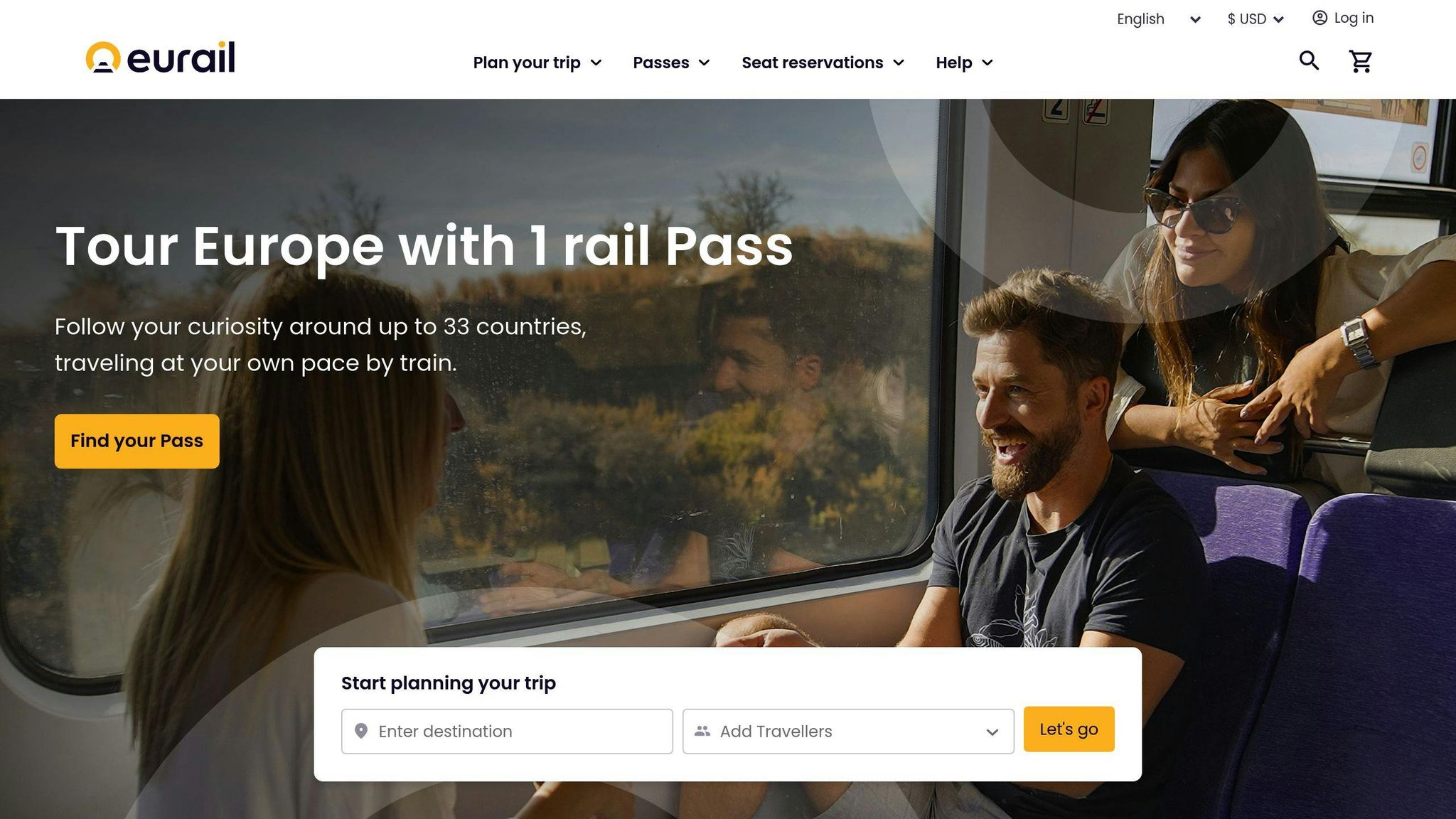A Eurail Pass can be an excellent choice for train travel across Europe, but it depends on your travel plans. Here’s a quick breakdown to help you decide:
- Best for: Multi-country trips, long-distance routes, and flexible itineraries in Western and Central Europe.
- Not ideal for: Single-country travel, short regional trips, or fixed itineraries where advance tickets are cheaper.
- Key benefits: Unlimited train rides in 33 countries, discounts on ferries, museums, and more. Great for high-speed and scenic routes like the Glacier Express.
- Extra costs: Seat reservations are required for many high-speed trains (€10-23).
Quick Overview
| When It’s Worth It | When It’s Not Worth It |
|---|---|
| Visiting multiple countries | Staying in one country or short trips |
| Long-distance/high-speed train routes | Fixed itineraries with advance bookings |
| Flexible travel plans | Eastern Europe where buses are cheaper |
If your trip involves extensive travel across Western Europe with flexibility, a Eurail Pass can save time and money. For shorter or fixed trips, individual tickets might be more cost-effective.
Eurail Pass Explained: Everything You Need to Know
Understanding the Eurail Pass
The Eurail Pass offers access to Europe’s extensive train network, covering 33 countries. It’s a convenient travel document designed for international visitors exploring Europe by rail [3][4].
Main Features of the Eurail Pass
The Eurail Pass allows unlimited train rides within participating countries during its validity period [3]. You’ll need to activate it within 11 months of purchase, giving you plenty of time to plan your trip [3].
It also comes with added perks, including:
- Discounts on city cards, boat tours, accommodations, museums, and local transportation [4].
Different Types of Eurail Passes
Eurail offers several pass options tailored to different travel styles. Here’s a quick overview:
| Pass Type | Description | Best For |
|---|---|---|
| Continuous Pass | Unlimited travel for consecutive days | Frequent travel in a short time |
| Flexible Pass | Travel on selected days within a set period | Occasional travel with breaks |
| Global Pass | Access to all 33 participating countries | Multi-country trips |
| Single-Country Pass | Travel within one specific country | Focused exploration of one area |
When deciding, think about how often you’ll travel and where you’re headed. For instance, a Continuous Global Pass is great for frequent multi-country trips, while a Flexible Pass is better for longer stays with occasional train rides [3][4].
Keep in mind that high-speed and overnight trains may require seat reservations, especially during busy travel seasons [3][4].
Knowing the features and options of the Eurail Pass can help you decide if it’s the right fit for your European adventure.
When a Eurail Pass is a Good Choice
A Eurail Pass can be a smart option for certain travelers and specific travel plans. Here’s when it can save you time, money, and hassle.
Ideal for Long-Distance or Multi-Country Trips
If your trip involves visiting multiple countries in Western and Central Europe, the Eurail Pass can be a great fit. These regions have extensive and efficient train networks, especially in countries like France, Germany, Italy, and Switzerland. For example, routes between cities such as Paris, Amsterdam, and Berlin can cut costs by up to 50% compared to buying individual tickets [3].
The pass is especially useful if you:
- Plan to visit several countries in a short period
- Focus on destinations in Western and Central Europe
- Expect to take multiple long-distance train rides
- Want access to well-connected rail systems
Great for Flexible Travel Plans
If you’re the type of traveler who enjoys flexibility, the Eurail Pass is a solid option. It allows you to adjust your plans on the go – whether that means staying longer in one city or hopping on a last-minute train. This makes it perfect for those traveling without a fixed itinerary.
Added Perks and Discounts
The Eurail Pass doesn’t just cover train rides. It also comes with discounts on ferries, museum entries, local transit, and even group travel. Services like Traindrop can help you take full advantage of these extras, making the pass even more appealing for budget-conscious travelers [5].
While the Eurail Pass offers clear advantages in these situations, it might not be the best choice for every traveler or itinerary.
When a Eurail Pass May Not Be Worth It
While Eurail Passes can be a good option for some travelers, they don’t always make sense in every situation. Let’s look at a few scenarios where they might not be the best choice.
Better for Short or Regional Trips
For shorter or regional journeys, point-to-point tickets are often the cheaper option. For example, a one-way ticket from Paris to Lyon typically costs around €45-65, which is much less than the daily rate of most Eurail Passes. This is especially true if you’re:
- Spending an extended period in one country
- Taking only a handful of train rides
- Traveling between cities that are close to each other
In these cases, buying individual tickets makes more financial sense.
Less Useful in Eastern Europe or the Balkans
In Eastern Europe and the Balkans, the Eurail Pass often doesn’t offer great value. Rail networks in this region are less developed, and buses or other forms of transportation are usually more affordable and convenient. For example:
| Service | Average Cost Range |
|---|---|
| Local Buses | €5-15 per journey |
| Regional Trains | €10-25 per journey |
| Private Shuttles | €15-30 per journey |
"Research indicates 70% of Eastern European travelers prefer buses for better coverage and affordability" [2].
In these countries, buses and private shuttles often provide better coverage and lower costs compared to trains.
Not Ideal for Fixed Itineraries
If your trip is already planned with exact dates and routes, booking tickets directly through train operators is usually cheaper than using a Eurail Pass. For example, booking a Berlin to Munich ticket three months in advance can cost as little as €29.90, whereas a daily Eurail Pass rate might exceed €50.
Here are a few tips for saving money on fixed itineraries:
- Book non-refundable tickets 2-3 months ahead for the lowest prices.
- Use regional train operator websites for direct bookings.
- Combine different types of transportation (like buses or budget flights) for better savings.
- Check comparison platforms like Traindrop to find the best deals for your routes.
Also, keep in mind that high-speed trains often require mandatory seat reservations, which can make advance tickets even more cost-effective than a Eurail Pass.
How to Get the Most Out of Your Eurail Pass
These tips are especially helpful for trips involving high-speed trains or scenic routes, where using the Eurail Pass can save you the most money.
Focus on High-Speed and Scenic Routes
To get the best value from your Eurail Pass, prioritize pricey high-speed trains and scenic routes. For example, individual tickets for trains like the TGV in France or ICE in Germany can cost between €100-200 per trip. Using your pass for these routes makes it a smart investment. Here are some routes where the pass offers great savings:
| Route | Regular Price | Required Reservation |
|---|---|---|
| Paris-Amsterdam (Thalys) | €120-180 | €20-30 |
| Munich-Vienna (Railjet) | €89-120 | €3-5 |
| Zurich-Milan (EuroCity) | €75-130 | €10 |
Switzerland’s Glacier and Bernina Express trains are another great choice. Not only do they offer breathtaking Alpine views, but tickets can also exceed €150 – making them a perfect use of your pass.
Be Aware of Seat Reservation Fees
Many high-speed trains in countries like France, Italy, and Spain require seat reservations, which come with additional fees (€10-23). In Germany, ICE trains offer optional reservations for €4. Here’s a quick overview:
| Country | Train Type | Reservation Fee |
|---|---|---|
| France | TGV | €10-20 |
| Italy | Frecce | €10 |
| Spain | AVE | €10-23 |
| Germany | ICE | Optional (€4) |
It’s a good idea to book your reservations up to three months in advance, especially during the busy travel season from June to September.
Use Tools Like Traindrop
Traindrop is a handy tool for getting the most out of your Eurail Pass. It offers:
- Real-time updates on reservation rules
- Guides for popular routes
- Details on train amenities and services
- Advice on minimizing reservation fees
"The key to maximizing your Eurail Pass value is strategic planning of high-cost routes while being mindful of reservation fees. Using planning tools can help you save up to 40% on your overall journey costs" [1].
If you’re planning a complicated itinerary, Traindrop’s scheduling tools can help you coordinate connections and reservations. This can save you from last-minute changes or missed connections that might waste a travel day on your pass.
Conclusion: Should You Get a Eurail Pass?
Budget and Travel Considerations
Whether a Eurail Pass is worth it depends on your travel plans and budget. If you’re planning extensive travel across Western and Central Europe, especially involving multiple countries or long-distance routes, the pass can help you save money [8].
It’s most useful for:
- Trips covering multiple countries in Western or Central Europe
- Flexible itineraries that don’t require advance bookings
- Long-distance routes (over 300km) between major cities
However, it’s not as cost-effective for single-country trips, regional travel, or journeys focused on Eastern Europe, where individual tickets are often cheaper [3].
Your choice should reflect how well the Eurail Pass fits your travel preferences and plans.
Key Considerations
Think about your travel priorities when deciding on a Eurail Pass. While it offers flexibility, some countries require seat reservations, which can reduce spontaneity [3].
To get the most out of your pass, focus on high-cost routes and try to keep reservation fees low. Tools like Traindrop can help you calculate savings, manage reservations, and plan efficient routes.
In short: The Eurail Pass is ideal for flexible, wide-ranging train travel in Western and Central Europe. For shorter or more fixed trips, individual tickets might be the better choice. Let your travel style, routes, and need for flexibility guide your decision.
FAQs
Here are answers to common questions and tips to help you get the most out of your Eurail Pass.
How can I get the most value from my Eurail Pass?
- Pick the Right Pass: Choose a pass that matches your travel schedule. For example, a 5-day pass within 1 month works well for five major trips over three weeks [3].
- Plan Smart Routes: Use tools like Traindrop to find scenic and high-value routes. Prioritize high-speed and premium trains where the pass offers better savings [1].
- Save on Short Trips: For shorter, cheaper routes, buy regional tickets instead of using a pass day. For instance, paying €20 for a local trip can save a pass day worth €50 [1].
What perks come with the Eurail Pass?
Your Eurail Pass isn’t just for train rides. It also includes:
- Discounts on boat tours and scenic train routes
- Special rates at select hostels
- Free entry to some railway lounges
- Flexibility to adjust your plans without extra fees
Do I need to validate my pass?
Yes, validation is necessary before your first trip. Additionally, some trains – especially high-speed ones – require seat reservations [3]. Use tools like Traindrop to manage reservations and make the most of your pass.
"The key to maximizing your Eurail Pass value is strategic planning of high-cost routes while being mindful of reservation fees. Using planning tools can help you save up to 40% on your overall journey costs" [1].

